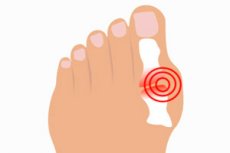Metformin given to patients with prediabetes reduces the risk of developing gout
Last reviewed: 14.06.2024

All iLive content is medically reviewed or fact checked to ensure as much factual accuracy as possible.
We have strict sourcing guidelines and only link to reputable media sites, academic research institutions and, whenever possible, medically peer reviewed studies. Note that the numbers in parentheses ([1], [2], etc.) are clickable links to these studies.
If you feel that any of our content is inaccurate, out-of-date, or otherwise questionable, please select it and press Ctrl + Enter.

Metformin given to patients with prediabetes also reduced the risk of developing gout, a new study finds.
Among 1,154 people with elevated hemoglobin A1c (HbA1c) levels, just below the threshold for type 2 diabetes, who started taking metformin, gout was diagnosed at an incidence of 7.1 per 1,000 person-years (95% CI 5.1-10.0) during a median follow-up of 4 years, according to data presented by Javier Marrugo, MD from Brigham and Women's Hospital in Boston, and his colleagues.
Gout occurred at an incidence of 9.5 per 1000 person-years (95% CI 8.8-10.2) among nearly 14,000 similar patients who did not started metformin, resulting in a relative risk of 0.68 (95% CI 0.48-0.96) for metformin use, the researchers reported in the Annals of the Rheumatic Diseases.
Interestingly, however, metformin seemed to have no effect on either serum uric acid levels or C-reactive protein (CRP), which complicates the interpretation of the results.
This is not the first study to find a link between antidiabetic drugs and a reduced risk of gout. This association has previously been noted for the so-called gliflozin drugs, which increase urinary glucose excretion, although in these cases uric acid levels were reduced.
Metformin is, of course, the most common first-line treatment for type 2 diabetes, and its relative safety has made it the drug of choice for people with prediabetes (defined in this study as an HbA1c of 5.7%-6.4%). Marrugo et al noted that many studies of metformin have documented its anti-inflammatory effects. "Thus, in addition to its established role in reducing diabetes risk, metformin may also be associated with a lower risk of gout in individuals with prediabetes," they explained.
In the current study, Marrugo's team looked at data from 50,588 patients treated at the Mass General Brigham health system from 2007 to 2022 for prediabetes. Half were excluded because of a rapid diagnosis of type 2 diabetes or gout, or because less than one year of data was missing. Of the approximately 25,000 remaining, the researchers identified 1,172 metformin users and 23,892 otherwise treated patients. Eighteen metformin users and 10,015 nonusers could not be matched by propensity, leaving 1,154 and 13,877, respectively, for analysis.
Approximately two-thirds of the participants were women, with an average age of 57 years. Just over 60% were white. The average body mass index was about 32; HbA1c averaged 6.0%. Participants who did not use metformin did not receive any other glucose-lowering medications. In both groups, 10%-12% took aspirin and about the same number took antihypertensive drugs.
Kaplan-Meier analysis covering 5 years of follow-up showed a difference in gout incidence between groups starting after just a few months. At 5 years, 30 metformin users (2.6%) developed gout compared with 546 (3.9%) nonusers (P=0.032 for trend). Most of those who developed gout were men.
Serum uric acid levels were slightly lower in the metformin group, but not at a significant level (P=0.73); levels decreased over time in both groups at the same rate. The same went for CRP. As expected, metformin was effective in reducing HbA1c levels, with a reduction of 0.14 percentage points after one year.
Marrugo et al did not attempt to explain how metformin might reduce the risk of gout without overtly reducing uric acid levels, but noted that the drug lowers HbA1c and appears to cause some weight loss; these effects have previously been associated with a reduction in systemic inflammation (although no effect on CRP was found in the current study). In addition, the researchers noted that earlier studies showing the uric acid-lowering effect of gliflozin drugs were conducted in people with full-blown diabetes, whereas the new study looked only at people with less pronounced increases in HbA1c.
Limitations of the study include the preponderance of women in the sample, whereas gout primarily affects men. The retrospective, observational design and lack of data on lifestyle factors also mean that unaccounted for confounders could have influenced the results.
